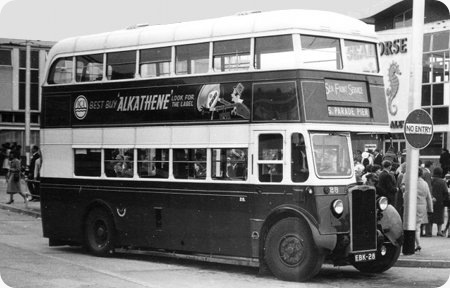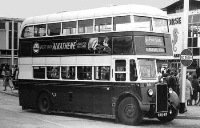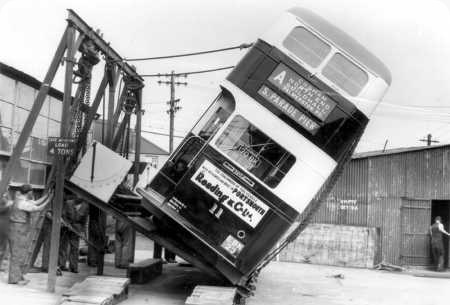Portsmouth Corporation – Crossley DD42/5 – EBK 28 – 28

Photo reproduced with kind permission of Alan Lambert.
Portsmouth Corporation
1949
Crossley DD42/5
Reading H52R
Portsmouth had four Crossley DD42/5’s (11-14) delivered in 1948 and two (15 & 28) in 1949. The first four had German Imperial Navy-type crosses on the radiators: the last two had CROSSLEY plates on them. They all had Brockhouse Turbo-transmitters and, according to Michael Hampton (who commented on a photo of a DD42/7 I submitted earlier) retained them to the the end of their service days. The locally-built Reading bodies they wore had also been fitted to 6 Leyland PD1/1A’s delivered earlier, in 1947/48. They bore some resemblance (especially at the front) to the Craven-bodied trolleybuses Portsmouth had at the time, there is a shot of one here.
As I recall, and unlike the DD42/7’s, they seemed to be very coy buses in the fleet, usually working routes needing only one bus, or peak-time reliefs or, as here, at Clarence Pier, Southsea, working the Sea Front Service on a cloudy or chilly day in May 1961, in place of the open-top TD4’s.
Incidentally, since only a few months separated the delivery of these 42/5’s from the 42/7’s, were there ever any DD42/6’s?
Photograph and Copy contributed by Chris Hebbron
Thanks for posting the two Portsmouth Corporation Crossley’s. My how they bring back memories. When both these Crossley’s ran, I lived on the ‘Tipner Estate’, in Tipner Green. We always seemed to get the Buses on this route (service ‘O’ & ‘P’ that later became service ’13’ & ’14’), that were near their withdrawal time. The ‘Reading’ bodied Crossleys did indeed keep their Crossley Engines & Brockhouse Turbomotor Transmitter’s to the end.
As a kid, I would spend hours at ‘Range Green’ (their ‘Tipner’ terminus) as they used to reverse into the beginning of Range Green, to face the correct way in Tipner Lane for the return journey. You would often see the Driver standing up in the cab trying to move the stuck ‘direction’ lever, which looked just like a normal Gear lever which you pushed forward to go forwards and pulled back to reverse, between these was neutral. The trick for an easy change of direction was to knock the lever into neutral just before coming to a halt, then stop, then using the ‘Heel Pedal’ under the Drivers seat which was supposed to (but rarely did) stop the transmission from turning, snatch the direction lever quickly to the direction you want to go.
John
The O & P route was just the sort of quiet route these vehicles trod for year in and year out. Oh, and we always called Tipner, Tipnor – strange how it had two spellings.
Chris Hebbron
As it seems empty (look upstairs), do we take it that the rear suspension is a bit, shall we say, tired, or someone has left a very heavy parcel under the stairs? Or are all the passengers standing on the platform?
Joe
I love the thought of 52+8 standing, 60 folk crammed on the platform (probably having to leave the conductor behind!) but it may be that the bus is pulling away from the bus stop and causing the apparent tilt backwards and perhaps towards the camera a little, too.
Chris Hebbron
This is true,’Tipner’ was the correct spelling for that Estate, but there was also a ‘Tipnor’ spelling for a road just off ‘Twyford Avenue’ (probably doesn’t exist after the placement of the ‘M27’ Motorway build in the 1970’s).
John
The Reading bodywork was a very ‘handsome’ affair with clean cut lines, and polished interior woodwork with half drop ventilator windows but sadly, this body, was not the most rugged or durable in practice. This would explain the early withdrawal of the Crossley’s and the PD1/PD1A with these bodies. This may also explain why the ‘Reading’ Bodied vehicles kept their troublesome Crossley engines & Brockhouse/Salerni Turbomotor/Transmitter Converters to the end.
John
Yes, I always had a soft spot for the looks of the Reading-bodied vehicles.
Towards the end, even the Crossley bodies on the DD42/7’s suffered from body problems. I can recall sitting in the front downstairs saloon seats and noticing that fatigue cracks were appearing in a central spar which ran below the windows. Several buses had had the ‘dodgy’ part covered in varnished wood, one must hope after welding work had been done!
Chris Hebbron
The number of dodgy bodies – and coachbuilders – from the end of WW2 to 1950 is legion, for the most part due to or contributed to by the lack of quality parts and materials as a consequence of the war.
Interestingly enough, you could say that Crossley bodies were of two distinct types – both generally regarded as of high quality.
Due to immense Manchester Corporation influence, the majority of pre-war – and post-war to 1950 – bodies were on Metro-Cammell frames (then regarded as by far the best and most reliable all metal frames). This, of course, made them compatible with most of the rest of MCT’s fleet of Met-Camm bodies. After the AEC/ACV take over, most Crossley bodies were on Park Royal frames (another quality product) but made them (like similar Roe bodies) into PRV clones.
A prime example of dodgy coachwork was Windover which was luxurious "in the extreme" but fell apart rapidly with it’s "green" wood frames.
David Oldfield
I have to admit, I did not know that C.P.P.T.D. Had had trouble with the Crossley Bodies too ! I do remember, as a kid, aiming for the single seat on either side which was located in the centre of the lower saloon (only on those that hadn’t been up seated to standard layout). The rore of the transplanted 8.6 Litre Leyland Engine, and whine from the 1930’s (ex) TD4 ‘crash’ Gearbox’s. I never remember any of them breaking down even though the engine and gearbox was over twenty years older than the rest of the Bus !!
John
I don’t think the comment about Metro-Cammell frames is quite right. Pre-war yes, Manchester had vast numbers of "Crossley-MetroCammell" bodies. But both of the seminal works by Eyre and Heaps ("The Manchester Bus" and "Crossley") state that post-war Crossley bodies used Crossley’s own framing, and speak very highly of it.
The Park Royal framed Crossley bodies should have been of high quality, but many of them weren’t, because by then Crossley was in its death-throes, morale was low and nobody was interested in quality. Preston is one operator that had to do substantial rebuilding work on these bodies.
Peter Williamson
In my copy above, I posed the question as to whether there had ever been any Crossley DD42/6’s. By chance, I’ve found out that, in 1949, Birmingham Corporation took delivery of eight DD42/6’s and one DD42/6T. This was just before their great influx of Daimlers, Guys and Crossley DD42/7’s in 1950. So if Portsmouth’s DD42/5’s were delivered in 1949 and B’ham Corp’n’s were DD42/7’s in 1950, not many DD42/6’s could have been made in the interim, but some were.
Chris Hebbron
The comments from Chris Hebron about the DD42/6 Crossley’s, reminded me of an almost identical scenario with the pre-war Leyland Titans.
There were TD1 – TD5 Chassis then a handful of TD6’s for one operator, before the arrival of the TD7 in 1942. The War stopped further production ’til the post-war PD1 with its rather ‘clattery’ E181, 7.4 Litre Engine.
John
 Vehicle reminder shot for this posting
Vehicle reminder shot for this posting
21/02/13 – 06:14
I recall reading once that Leyland’s 7.4 litre engine was originally developed for use in wartime tanks!
Chris Hebbron
21/02/13 – 07:14
Yes, Chris, and used in tandem – two at a time, like DMUs.
David Oldfield
21/02/13 – 08:43
Interesting. It may well be then, David, that all 7.4 powered buses were secretly part of the UK’s strategic military reserve!
Chris Hebbron
Quick links to the - Comments Page - Contact Page - Home Page
Please leave a comment
Please Note if you want to send a photograph with your comment please use the Contact Page by clicking here or send as an attachment via email.

